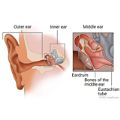Our Health Library information does not replace the advice of a doctor. Please be advised that this information is made available to assist our patients to learn more about their health. Our providers may not see and/or treat all topics found herein. A hearing (audiometric) test is part of an ear exam that tests how well a person is able to hear. It is done by measuring how well sound can reach the brain. The sounds we hear start as vibrations in the air around us. The vibrations make sound waves, which vibrate at a certain speed (frequency) and have a certain height (amplitude). The vibration speed of a sound wave determines how high or low a sound is (pitch). The height of the sound wave determines how loud the sound is (volume). Hearing happens when these sound waves travel through the ear and are turned into nerve impulses. These nerve impulses are sent to the brain, which "hears" them. Hearing tests help find what kind of hearing loss you have. The tests measure how well you can hear sounds that reach the inner ear through the ear canal. They also measure sounds that are spread through the skull. Most hearing tests ask you to respond to a series of tones or words. But there are some hearing tests that do not require a response. Hearing tests may be done: Before you start any hearing tests, your ear canals may be checked for earwax. Wax can affect how well you hear. Any hardened wax may be removed. If you wear hearing aids, you may be asked to remove them for some of the tests. Your doctor strikes the tuning fork to make it vibrate and produce a tone. Sometimes the tuning fork will be placed on your head or behind your ear. A machine called an audiometer plays a series of tones through headphones. The tones change in pitch and loudness. Your doctor will reduce the loudness of a tone until you can no longer hear it. Then the tone will get louder until you can hear it again. If you can hear the tone, you signal by raising your hand or pressing a button. The headphones will then be removed. A special vibrating device will be placed on the bone behind your ear. Again, you will signal each time you hear a tone. In these tests, you hear a series of simple words spoken with different degrees of loudness. You are asked to repeat the words. Your doctor measures the level at which you can no longer hear the words well enough to repeat them. In this test, electrodes are placed on your scalp and on each earlobe. Clicking noises are then sent through earphones. The electrodes monitor your brain's response to the clicking noises and record the response on a graph. This test usually doesn't cause any pain or discomfort. There are no known risks from having this test. Normal Abnormal Sound is described in terms of frequency and intensity. Your hearing threshold is how loud the sound of a certain frequency must be for you to hear it. The following table relates how loud a sound must be for a person to hear it (hearing thresholds) to the degree of hearing loss for adults: Hearing threshold in decibels (dB) Degree of hearing loss Ability to hear speech 16–25 dB Slight Trouble with faint or distant speech. 26–40 dB Mild Trouble with faint or distant speech. 41–55 dB Moderate Trouble with conversational speech. 56–70 dB Moderate to severe Speech must be loud; trouble with group conversation. 71–90 dB Severe Trouble with loud speech. Understands only shouted or amplified speech. 91+ dB Profound May not understand amplified speech. Current as of: October 27, 2024 Author: Ignite Healthwise, LLC Staff Current as of: October 27, 2024 Author: Ignite Healthwise, LLC Staff Clinical Review Board This information does not replace the advice of a doctor. Ignite Healthwise, LLC disclaims any warranty or liability for your use of this information. Your use of this information means that you agree to the Terms of Use and Privacy Policy. Learn how we develop our content. To learn more about Ignite Healthwise, LLC, visit webmdignite.com. © 2024-2025 Ignite Healthwise, LLC.Hearing Tests
Test Overview
Why It Is Done
How To Prepare
How It Is Done
Before the test
Tuning fork tests
Pure tone audiometry
Speech reception and word recognition tests
Auditory brain stem response (ABR) testing
How long the test takes
How It Feels
Risks
Results
Related Information
References
Citations
Credits
Clinical Review Board
All Ignite Healthwise, LLC education is reviewed by a team that includes physicians, nurses, advanced practitioners, registered dieticians, and other healthcare professionals.
All Ignite Healthwise, LLC education is reviewed by a team that includes physicians, nurses, advanced practitioners, registered dieticians, and other healthcare professionals.
Our Health Library information does not replace the advice of a doctor. Please be advised that this information is made available to assist our patients to learn more about their health. Our providers may not see and/or treat all topics found herein. Current as of: October 27, 2024 Author: Ignite Healthwise, LLC Staff Clinical Review BoardHearing Tests
All Ignite Healthwise, LLC education is reviewed by a team that includes physicians, nurses, advanced practitioners, registered dieticians, and other healthcare professionals.





